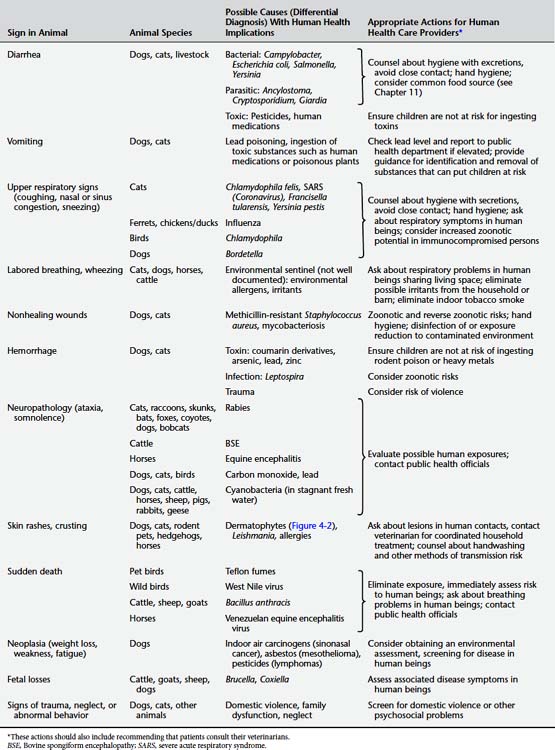4 Sentinel Disease Signs and Symptoms
Human Health Clinicians
Veterinary Clinicians
SIGNS OF ILLNESS IN ANIMALS THAT MAY BE RELEVANT TO HUMAN HEALTH
As mentioned in Chapter 3, in providing their medical histories, human patients may spontaneously mention particular health problems that have developed in their pets or other animals, perhaps thinking their own condition may be associated in some way with an ill animal. They may also provide information about the health of their animals in response to the directed questions listed in Chapter 3. Although a human health care provider should not attempt to offer advice about veterinary treatment (see Chapter 2), there are fundamental steps that he or she can take that may enhance the opportunities for early detection and prevention of human disease. In the case of the release of biological or chemical agents, either intentional or accidental, it is possible that sudden animal mortality or morbidity clusters could be an early warning sentinel event that would need to be recognized and acted on as soon as possible to reduce human health risks (see Chapter 13). The following section provides an overview of common clinical signs in animals, potential etiological agents, clinical and public health implications, and the next steps that human and animal health care providers should take if they learn of such conditions.
Types of Animal Diseases That May Be Important to Human Health Care Providers
In general, the human health consequences of a particular animal illness fall into two main categories (Figure 4-1). The first category is direct infection risk. The clinical sign is related to an infectious agent that could pass from the animal to the person, with the animal serving as a source for the zoonotic infection risk. An example may be the direct infection of a person tending a calf with cryptosporidial diarrhea after fecal material splashes directly into the person’s mouth. The second is as an environmental sentinel event. The clinical signs of the animal disease provide an indication of an environmental hazard, either infectious or toxic, to which human beings may also be exposed. For example, identification of Rocky Mountain spotted fever in dogs has led to the discovery and treatment of disease in a human patient.1 Similarly, a dog that becomes ill after ingesting toxic berries on an ornamental plant signals a potential danger for children who could inadvertently ingest the berries. Elevated blood lead levels in pets are an indicator of lead exposure risk in children living nearby.
Specific Signs in Animals and Appropriate Follow-up Steps for Human Health Professionals
Table 4-1 includes selected animal disease conditions for which a heightened index of suspicion for human disease risk is warranted, potential etiological agents and public health implications, and next steps for the human health care provider in protecting public health. A diagnosis in the animal should be pursued and human case findings similarly investigated while considering a common source of exposure.
Stay updated, free articles. Join our Telegram channel

Full access? Get Clinical Tree






